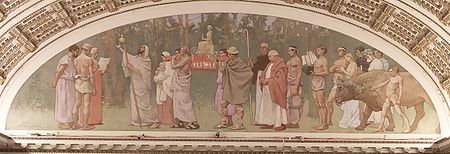Peace: Difference between revisions
NjardarBot (talk | contribs) m robot Adding: be-x-old:Мір |
|||
| Line 126: | Line 126: | ||
</div> |
</div> |
||
#''The Path to Peace,'' by Laure Paquette |
#''The Path to Peace,'' by Laure Paquette |
||
* Markwell, Donald, ''John Maynard Keynes and International Relations: Economic Paths to War and Peace'', Oxford University Press, 2006. |
|||
==External links== |
==External links== |
||
Revision as of 07:52, 12 November 2008
This article needs additional citations for verification. (January 2007) |
This article may need to be rewritten to comply with Wikipedia's quality standards. |

Peace, in the modern usage, is a concept defined by the ideal state of relationship as absence of hostility, at the international level, that of a war.
Derived from the Anglo-Norman pas c.1140, and meaning "freedom from civil disorder", it came into use in various personal greetings from c.1300 as a Biblical translation of the Latin pax and Greek eirene, which were used by translators to render Hebrew shalom, which has multiple meanings of "safety, welfare, prosperity". The personalised meaning is reflected in a non-violent lifestyle which also describes a relationship between any people characterized by respect, justice, and goodwill. This latter understanding of peace can also pertain to an individual's sense of himself or herself, as to be "at peace" with one's own mind attested in Europe from c.1200. This approach to life with a sense of "quiet" attested in Europe by 1300, reflects a calm, serene, and meditative approach to the family or group relationships that avoids any quarrels, and seeks tranquility — an absence of disturbance or agitation. On the whole peace represents contentment.
In many ways these core meanings of peace define origins of conflict as insecurity, social injustice, economic inequality.
"Peace" is an ideal state that is used to describe the end of a conflict.
Nobel Peace Prize
The Nobel Peace Prize is awarded annually to notable peacemakers and visionaries who have overcome violence, conflict or oppression through their moral leadership, those who have "done the most or the best work for fraternity between the nations". The prize has often met with controversy, as it is occasionally awarded to people who have formerly sponsored war and violence but who have, through exceptional concessions, helped achieve peace.
Understandings of peace
This section needs expansion. You can help by adding to it. (April 2008) |
Many different theories of "peace" exist in the world of peace studies, which involves the study of conflict resolution, disarmament, and cessation of violence. [3] The definition of "peace" can vary with religion, culture, or subject of study.
Peace is a state of balance and understanding in yourself and between others where respect is gained by the acceptance of differences, tolerance persists, conflicts are resolved through dialogue, people's rights are respected and their voices are heard, and everyone is at their highest point of serenity without social tension.
Peace as the presence of justice

Mahatma Gandhi suggested that if an oppressive society lacks violence, the society is nonetheless not peaceful, because of the injustice of the oppression.[citation needed] Gandhi articulated a vision of peace in which justice is an inherent and necessary aspect; that peace requires not only the absence of violence but also the presence of justice.[citation needed] Galtung described this peace, peace with justice, as "positive peace," because hostility and further violence could no longer flourish in this environment.[citation needed]
During the 1950s and 60s, when Martin Luther King Jr. and the civil rights movement carried out various non-violent activities aimed at ending segregation and racial persecution in America, they understood peace as more than just the absence of violence. They observed that while there was not open combat between blacks and whites, there was an unjust system in place in which the government deprived African Americans of equal rights.[citation needed] While some opponents criticized the activists for "disturbing the peace", Martin Luther King observed that "True peace is not merely the absence of tension: it is the presence of justice."
Galtung coined the term structural violence to refer to such situations, which although not violent on the surface, harbor systematic oppression and injustice.[citation needed]
Peace in the presence of injustice
Since classical times, it has been noted that peace has sometimes been achieved by the victor over the vanquished by the imposition of ruthless measures. In his book Agricola the Roman historian Tacitus includes eloquent and vicious polemics against the rapacity and greed of Rome. One, that Tacitus says is by the British chieftain Calgacus, ends Auferre trucidare rapere falsis nominibus imperium, atque ubi solitudinem faciunt, pacem appellant. (To ravage, to slaughter, to usurp under false titles, they call empire; and where they make a desert, they call it peace. — Oxford Revised Translation).
Peace and development

One concept or idea that often complements peace studies is development. Economic, cultural, and political development can supposedly take "underdeveloped" nations and peoples out of poverty, thus helping bring about a more peaceful world. As such, many international development agencies carry out projects funded by the governments of industrialized countries, mostly the western, designed to "modernize" poor countries.[1]
The concept of peace has been linked to the wide idea of development, assuming that development is not the classical pursuit of wealth.[citation needed] Peaceful development can be a set of many different elements such as good governance, healthcare, education, gender equality, disaster preparedness, infrastructure, economics, rule of law, human rights, environment and other political issues. [citation needed] The measuring of development uses not only GDP but also numerous measures such as:
- Literacy rates
- Life expectancy
- Gini coefficient
- Per capita income
- Maternal survival rate
- HIV infection rates
- Number of doctors per capita
- Human Development Index
- and others
In this frame, the problem of peace fully involves the complex matter of human development, what explains the complexity of any peace-building processus.
Peace is what happens when all peoples are free to develop themselves in the way they want, without having to fight for their rights.
— Bruno Picozzi[2]
Democratic peace theory
Proponents of the democratic peace theory argue that strong empirical evidence exists that democracies never or rarely make war against each other. An increasing number of nations have become democratic since the industrial revolution, and thus, they claim world peace may become possible if this trend continues.
Capitalism peace theory
In her capitalism peace theory, Ayn Rand [3] holds that the major wars of history were started by the more controlled economies of the time against the freer ones and that capitalism gave mankind the longest period of peace in history -- a period during which there were no wars, involving the entire civilized world -- from the end of the Napoleonic wars in 1815 to the outbreak of World War I in 1914.
It must be remembered that the political systems of the nineteenth century were not pure capitalism, but mixed economies. The element of freedom, however, was dominant; it was as close to a century of capitalism as mankind has come. But the element of statism kept growing throughout the nineteenth century, and by the time it blasted the world in 1914, the governments involved were dominated by statist policies.
Peace movements and activism
Main article: Peace movement
Peace movements are comprised of socially active individuals and groups that seek to achieve ideals such as the ending of a wars and minimizing inter-human violence. Means to achieve these ends usually include advocacy of pacifism, non-violent resistance, diplomacy, boycotts, moral purchasing, supporting anti-war political candidates, demonstrations, and National Political lobbying groups to create legislation.
Plural peaces
Following Wolfgang Dietrich, Wolfgang Sützl, and the Innsbruck School of Peace Studies, some "peace thinkers" have abandoned any single and all-encompassing definition of peace. Rather, they promote the idea of many peaces. They argue that since no singular, correct definition of peace can exist, peace should be perceived as a plurality.[4]
For example, in the Great Lakes region of Africa, the word for peace is kindoki, which refers to a harmonious balance between human beings, the rest of the natural world, and the cosmos. This vision is a much broader view of peace than a mere "absence of war" or even a "presence of justice" standard.[5]
These thinkers also critique the idea of peace as a hopeful or eventual end. They recognize that peace does not necessarily have to be something humans might achieve "some day." They contend that peace exists in the present, we can create and expand it in small ways in our everyday lives, and peace changes constantly. This view makes peace permeable and imperfect rather than static and utopian.[6]
Such a view is influenced by postmodernism.
Inner peace
One meaning of peace refers to inner peace, a state of mind, body and mostly soul, a peace within ourselves. People that experience inner peace say that the feeling is not dependent on time, people, place, or any external object or situation, asserting that an individual may experience inner peace even in the midst of war. [citation needed] One of the oldest writings on this subject is the Bhagavad Gita, a part of India's Vedic scriptures.[7]
Sevi Regis describes inner peace as, "the state or condition of restfulness, harmony, balance, equilibrium, longevity, justice, resolution, timelessness, contentment, freedom, and fulfillment, either individually or simultaneously present, in such a way that it overcomes, demolishes, banishes, and/or replaces everything that opposes it."[citation needed]
Nonviolence and pacifism
Mahatma Gandhi's conception of peace was not as an end, but as a means: "There is no way to peace; peace is the way." Gandhi envisioned nonviolence as a way to make a political statement.[citation needed] Judeo-Christian tradition declares "Thou shalt not kill," although there is no consensus on the most accurate interpretation.
Followers of some religions, such as Jainism, go to great lengths to avoid harming any living creatures, including insects. Pacifists, such as Christian anarchists, perceive any incarnation of violence as self-perpetuating. Other groups take a wide variety of stances, many maintaining a Just War theory. Peace alta Peace euda.
See also
|
|
|
Notes
- ^ The website of the United States Agency for International Development website states: "Our Work supports long-term and equitable economic growth and advances U.S. foreign policy objectives by supporting: economic growth, agriculture and trade; global health; and democracy, conflict prevention and humanitarian assistance.[1]
- ^ Picozzi, Bruno (2007). BIPPI independent pro-peace initiative
- ^ Ayn Rand, "The Roots of War", Capitalism: The Unknown Ideal (1966), pg. 35-43.
- ^ A Call for Many Peaces, in: Dietrich/Echavarría/Koppensteiner: Key Texts of Peace Studies, Vienna, LIT Verlag, 2006. pages 282-305.[2]
- ^ Ibid.
- ^ Ibid.
- ^ Tirtha, Swami Sadashiva (2007). Bhagavad Gita for Modern Times (in commentary and translation). New York, USA: Sat Yuga Press. ISBN 978-0-9658042-6-4.
{{cite book}}: Cite has empty unknown parameter:|coauthors=(help)CS1 maint: unrecognized language (link)
References
- Letter from Birmingham Jail by Rev. Martin Luther King, Jr..
- "Pennsylvania, A History of the Commonwealth," esp. pg. 109, edited by Randall M. Miller and William Pencak, The Pennsylvania State University Press, 2002.
- Peaceful Societies, Alternatives to Violence and War Short profiles on 25 peaceful societies.
- The Path to Peace, by Laure Paquette
- Markwell, Donald, John Maynard Keynes and International Relations: Economic Paths to War and Peace, Oxford University Press, 2006.
